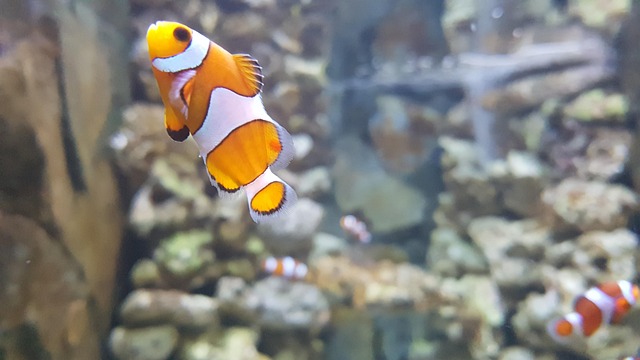Commercial aquarium displays serve as powerful educational tools for marine conservation, attracting millions of visitors annually to raise awareness about oceanic ecosystems. These public aquariums inspire appreciation and protection of aquatic habitats through interactive exhibits and sustainable practices. By showcasing diverse species and participating in breeding programs, they play a vital role in protecting endangered marine life. Global leaders like the Blue Planet Aquarium and Oceanarium set benchmarks with advanced water recycling, energy-efficient technologies, and active participation in marine research & education. The future of these displays is driven by eco-friendly practices, innovative designs for reduced environmental impact, and increased public awareness, creating captivating experiences that encourage sustainable community practices.
“Discover the evolving world of marine conservation through innovative eco-friendly exhibits. This article explores how commercial aquarium displays are not just entertainment hubs but powerful tools for safeguarding our oceans. From designing sustainable aquariums with minimal environmental impact to global success stories, we delve into the future of green aquarium design. Uncover the key considerations shaping the industry and learn how these exhibits foster awareness and protection for marine ecosystems.”
The Role of Commercial Aquarium Displays in Marine Conservation
Commercial aquarium displays, or public aquariums, play a pivotal role in marine conservation efforts by offering unique educational opportunities. These establishments attract millions of visitors annually, providing an accessible platform to raise awareness about oceanic ecosystems and their current threats. Through interactive exhibits and immersive environments, they can educate people from all walks of life about the importance of preserving our oceans.
Aquariums give audiences a glimpse into the diverse marine world, fostering a sense of connection and appreciation for aquatic habitats. By showcasing both local and exotic species, along with their natural behaviors, they inspire visitors to become stewards of the sea. Furthermore, many aquariums participate in breeding programs and conservation initiatives, contributing to the protection of endangered marine life.
Designing Eco-friendly Aquariums: Key Considerations for Sustainability
When designing eco-friendly aquariums, sustainability should be at the forefront of every decision. Commercial aquarium displays have a significant environmental impact, from energy consumption to water usage and waste generation. To create a more sustainable marine conservation exhibit, it’s crucial to incorporate energy-efficient lighting systems that minimize electricity use while optimizing light quality for aquatic life. Additionally, utilizing greywater recycling systems and implementing water treatment technologies that reduce chemical and nutrient loads can significantly cut down on water consumption and pollution.
The choice of materials is another key consideration. Opting for recyclable or biodegradable components in tank construction and exhibit furniture not only reduces waste but also minimizes the carbon footprint associated with production and transportation. Furthermore, incorporating natural elements like plants and rocks can enhance biodiversity and create more ecologically balanced habitats, while also providing educational opportunities to visitors about sustainable aquatic ecosystems.
Successful Examples of Sustainable Marine Conservation Exhibits Worldwide
Around the globe, several marine conservation exhibits stand out as successful examples of sustainable practices in commercial aquarium displays. One notable instance is the Blue Planet Aquarium in Birmingham, UK. This facility not only showcases a diverse array of marine life but also implements cutting-edge recycling systems for water and waste, significantly reducing its environmental footprint. By utilizing advanced filtration technologies and responsible resource management, Blue Planet Aquarium sets a high bar for eco-friendly operations.
Another inspiring model is the Oceanarium in Lisbon, Portugal. This magnificent exhibit combines breathtaking visual experiences with conservation efforts. The Oceanarium employs innovative design strategies, such as energy-efficient lighting and climate control systems, to maintain optimal conditions for its inhabitants while minimizing operational impact. Additionally, they actively participate in marine research and education programs, fostering a deeper understanding of ocean ecosystems among visitors and contributing to global conservation initiatives.
Future Trends and Innovations in Green Aquarium Design
The future of marine conservation exhibits leans heavily on sustainable and eco-friendly practices, with a particular focus on commercial aquarium displays. Innovative designs are emerging that prioritize energy efficiency, reduced water consumption, and advanced recycling systems. For instance, some cutting-edge aquariums utilize smart lighting technology to minimize energy waste while enhancing the health of aquatic ecosystems. Additionally, modular tank designs allow for better space utilization, reducing the overall footprint required for these exhibits.
Green aquarium design also incorporates advanced filtration methods and closed-loop systems that recirculate water, significantly lowering the need for fresh supplies. As public awareness about environmental conservation grows, these trends will likely gain traction. Such innovations not only contribute to the preservation of marine life but also create captivating experiences for visitors, fostering a deeper connection with nature and encouraging sustainable practices in the broader community.
Commercial aquarium displays, when designed with sustainability in mind, play a crucial role in marine conservation. By adopting eco-friendly practices and innovative green aquarium design trends, these exhibits can educate and inspire visitors while minimizing their environmental impact. The successful global examples highlighted in this article serve as a testament to the potential of sustainable marine conservation exhibits. As we look towards the future, continuous advancements in materials, technology, and operational efficiency will further revolutionize the industry, making marine conservation efforts more accessible, engaging, and environmentally responsible.
